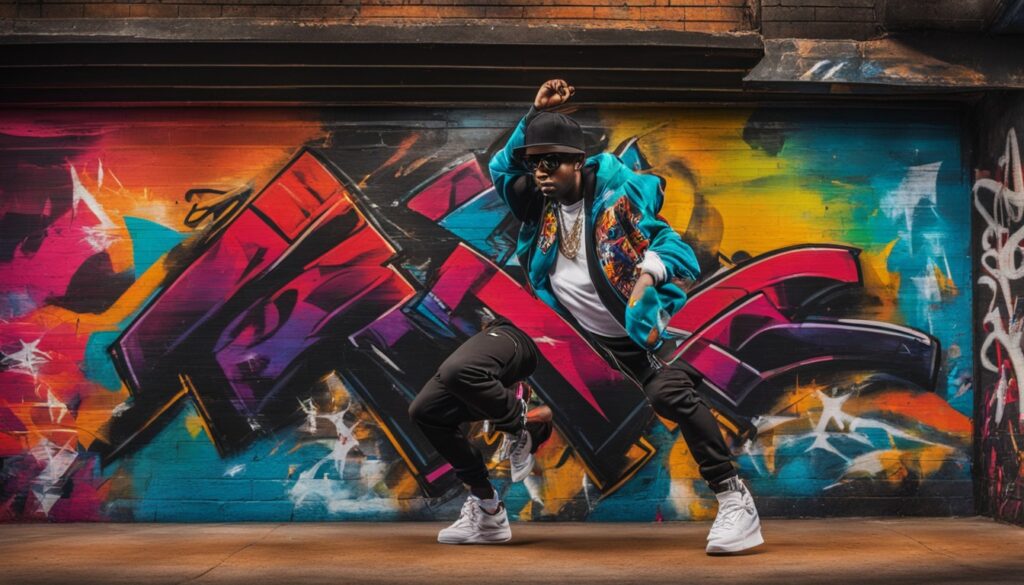Leonard Cohen’s song, “Famous Blue Raincoat”, talks about love, regret, and feeling alone. It came out in 1971 on the album Songs of Love and Hate. This song is still very popular today. It invites us into a world of strong feelings through a personal letter.
The song’s meaning connects to Cohen’s life and human emotions. It has infidelity and miscommunication, letting everyone find their own meaning. Even though Cohen wasn’t sure how clear the song was, people around the world love it for its deep feelings and artistry.
Cohen influenced music for six decades. In “Famous Blue Raincoat”, his talent for mixing personal stories with bigger ideas shines through. This song shows his skill in writing and sharing big truths simply and powerfully.
We’re starting with the Famous Blue Raincoat meaning to understand it better. We will look into its story, words, and lasting influence. This will help us see why “Famous Blue Raincoat” is still a major piece in Cohen’s work.
Key Takeaways
- “Famous Blue Raincoat” explores themes of love, regret, and miscommunication.
- Released in 1971 on the album Songs of Love and Hate.
- Written in the form of a personal letter with an ambiguous narrative.
- Remained one of Leonard Cohen’s most analyzed and covered songs.
- Cohen expressed uncertainty about the clarity of the song’s lyrics.
Background and Inspiration of Famous Blue Raincoat
Leonard Cohen’s “Famous Blue Raincoat” isn’t just a song. It’s a touching story, pulled from Cohen’s own life. It also reflects the dynamic 1970s music scene in Manhattan. The background of Famous Blue Raincoat is rich with Cohen’s personal drama. It captures the complex relationships and deep emotions of that time.
The Real-Life Raincoat
The story behind the Famous Blue Raincoat starts with a real Burberry raincoat. This coat, stolen from Marianne Ihlen’s apartment, represents a turbulent chapter in Cohen’s life. Cohen’s history includes complicated love stories, making him reflect on loyalty and betrayal. These elements shine through in the song.
Release and Song Structure
“Famous Blue Raincoat” was released in 1971. It’s a part of Cohen’s “Songs of Love and Hate” album. The song showcases the poetic and complex songwriting Cohen is known for. Its structure and vivid imagery transport listeners to Clinton Street in the 1970s.
In a 1994 BBC Radio interview, Cohen talked about feeling a third presence in his relationships. Sometimes, this presence was Cohen himself. The song shares this emotional journey. It talks about mixed feelings for a friend. Cohen’s storytelling, mixed with cultural references, makes this song timeless and meaningful.
Famous Blue Raincoat Meaning
Exploring Leonard Cohen’s “Famous Blue Raincoat” reveals layers of complex themes and personal thoughts. It tells a story through a letter about a love triangle. This format brings out feelings of betrayal, the act of forgiving, and deep interpretations.
Cohen’s words paint vivid pictures, blending masculine and feminine themes. His song, Famous Blue Raincoat, uses a simple but powerful image: a raincoat. This raincoat symbolizes protection and vulnerability.
Cohen appreciates Kurt Cobain’s mysterious way of writing songs. His lyrics, filled with contradictions, make “Famous Blue Raincoat” enchanting. References like “Lili Marlene,” Scientology, and Clinton Street add layers. These all stir emotions ranging from love to pain, offering a unique interpretation for each listener.
The song’s emotional impact comes from Cohen’s voice and the mix of story elements. It makes “Famous Blue Raincoat” a personal journey for each listener. Cohen himself said he was never completely happy with it. This invites us to dive deeper into the song’s complexities. It’s not just a song, but an ongoing discovery of meanings.
| Aspect | Details |
|---|---|
| Album | Songs of Love and Hate (1971) |
| Theft Incident | Leonard Cohen’s raincoat was stolen in the early 1970s from Marianne Ihlen’s New York apartment. |
| Popular Covers | Jennifer Warnes (1986), Joan Baez (1989), Tori Amos, Aurora, Eivor, The Handsome Family, Damien Rice, Glen Hansard |
| Personal Reflections | Cohen mentioned in 1994 that he was never fully satisfied with the song. |
| Musical Key | Starts in A minor, switches to C major during the choruses. |
Lyrical Analysis of Famous Blue Raincoat
Leonard Cohen’s song “Famous Blue Raincoat” tells a moving story through a letter. It starts in a sad way, with hints of blame. By using a special rhythm called amphibrach meter, Cohen makes the song flow beautifully.
The Letter’s Tone and Content
The song feels like a deep personal thought because of its letter form. Its rhymes and sounds make it feel like poetry. Words sound alike in a pleasing way, like “thin gypsy thief” and “It’s four in the morning, the end of December.”
The song talks about lost love and leaving, using both clear and hidden meanings. Sayings like “New York is cold” can mean more than one thing. The blue raincoat stands for hope, fame, and how things change over time.
Reference to Scientology and Personal Themes
An interesting part is the mention of Scientology with “Did you ever go clear?” This mixes with Cohen’s deep thoughts and personal stories. The song shows a time of thinking and changing for Cohen, with moves and personal shifts.
Through moving stories and deep symbols like the Famous Blue Raincoat, Cohen’s song connects with many. Its last words about taking away someone’s troubles hint at understanding or healing. It reflects Cohen’s reflective style of writing.
The song shows how Cohen kept rethinking and reworking his life stories. It’s a process that gives the song a lasting appeal. It invites us to explore its deep feelings and themes.
Here’s a detailed breakdown of the song’s poetic devices and themes:
| Poetic Device | Example | Impact |
|---|---|---|
| Alliteration | “thin gypsy thief” | Creates rhythm and emphasizes key concepts. |
| Assonance | “It’s four in the morning, the end of December” | Enhances the lyrical quality and mood. |
| Amphibrach Meter | Various lines throughout the song | Provides a rhythmic and melodic structure. |
| Symbolism | Famous Blue Raincoat | Represents hope, passage of time, and personal change. |
Impact and Reception
The release of Famous Blue Raincoat deepened Leonard Cohen’s remarkable career. His skill in turning poetry into song made this track unforgettable. The song’s *impact of Famous Blue Raincoat* was immediate, touching fans and critics.
Leonard Cohen’s songs received high praise from the start. “Famous Blue Raincoat” stood out for its complex lyrics and touching story. It has inspired much *critical analysis Famous Blue Raincoat*, drawing essays and studies to explore its depth.
The *impact Famous Blue Raincoat* goes beyond first impressions. It’s seen as one of Cohen’s best and features in many compilations like “I’m Your Fan.” This has secured its legacy in music history.
The enduring *reception Leonard Cohen songs* highlight their lasting charm. “Famous Blue Raincoat” is celebrated for its moving lyrics and depth. Below, compare durations of some of Cohen’s top songs:
| Song | Album | Duration |
|---|---|---|
| “Dance Me to the End of Love” | Live in London (2009) | 6:20 |
| “First We Take Manhattan” | I’m Your Man (1988) | 6:01 |
| “Suzanne” | Songs of Leonard Cohen (1968) | 3:46 |
| “Avalanche” | Songs of Love and Hate (1971) | 5:07 |
| “Chelsea Hotel #2” | New Skin for the Old Ceremony (1974) | 3:09 |
| “Darkness” | Old Ideas (2012) | 4:31 |
| “Nevermind” | Popular Problems (2014) | 4:40 |
| “Lover Lover Lover” | New Skin for the Old Ceremony (1974) | 3:24 |
| “Famous Blue Raincoat” | Songs of Love and Hate (1971) | 5:16 |
| “Bird on a Wire” | Songs from a Room (1969) | 3:24 |
Legacy and Cover Versions
“Famous Blue Raincoat” by Leonard Cohen has an incredible legacy. It has won the hearts of music fans all over. The song, with its deep lyrics and sad tune, has inspired many artists. Jennifer Warnes made an album called “Famous Blue Raincoat” in the 80s. This brought more people to appreciate Cohen’s songs.
Joan Baez and Tori Amos have each covered the song. Baez added her own emotional depth. Amos brought her unique intensity to it. These artists have made the song their own while keeping its reflective soul. It shows how “Famous Blue Raincoat” keeps inspiring musicians across different eras.
Leonard Cohen talked about the song’s different aspects in interviews. He appreciated the new layers others found in it. The song’s lasting charm shows Cohen’s huge impact on music. His artistry lives on, honored in covers, performances, and tributes. This ensures his legacy endures with fans and other artists.
FAQ
What is the meaning behind “Famous Blue Raincoat” by Leonard Cohen?
“Famous Blue Raincoat” tackles betrayal, forgiveness, and personal struggle. It’s seen as partly based on Cohen’s life, showing a complex love triangle. This song blends his experiences with universal truths, making it relatable.
What is the historical context and background of “Famous Blue Raincoat”?
Leonard Cohen wrote it, releasing it in 1971 on “Songs of Love and Hate.” The song was inspired by someone stealing Cohen’s coat. It reflects the 1970s music vibe of Clinton Street, Manhattan.
How does “Famous Blue Raincoat” use symbolism and metaphors in its lyrics?
The song uses the raincoat as a symbol for the past and memories. The lyrics include deep thoughts, like “Did you ever go clear?” These add meaning to the story in the song.
What is the tone and content of the letter format used in “Famous Blue Raincoat”?
The song’s letter format mixes sadness, giving up, and mild blame. This style makes the narrative feel close and deep, showing strong emotions.
What allusions to Scientology and personal themes are present in “Famous Blue Raincoat”?
It mentions “Did you ever go clear?”, linking to Scientology. This, and other personal topics, show Cohen’s deep thoughts and life at the time of writing.
How was “Famous Blue Raincoat” received by fans and critics upon its release?
Fans and critics loved the song for its intricate writing and emotion. Through years, it’s stayed a top work of Cohen’s, receiving high praise and honors.
What are some notable cover versions of “Famous Blue Raincoat”?
Jennifer Warnes, Joan Baez, and Tori Amos each covered the song. They each added their own style to Cohen’s original, showing its lasting appeal.
What is the legacy of “Famous Blue Raincoat” in music history?
The song has deeply affected both artists and music fans globally. Cohen’s own words and shows over time highlight its value. It’s a meaningful song with themes that still touch listeners today.


